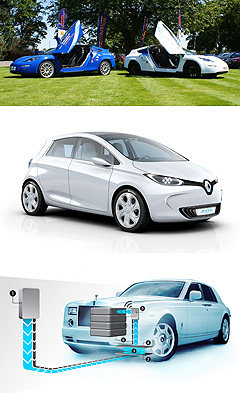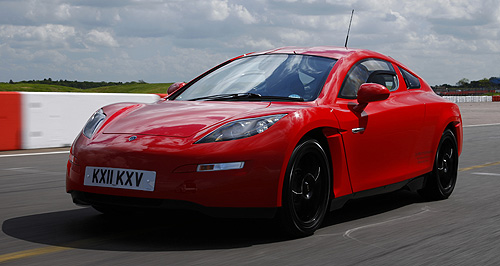Make / Model Search
News - General News - Electric VehiclesRenault signs up for wireless EV charging trialBeam me up: Not having to plug in EVs will help speed their adoption, according to technology firm Qualcomm and French car-maker Renault. London trial for wireless EV charging as Renault teams up with tech firm Qualcomm25 Jul 2012 WIRELESS EV charging is a step closer to commercial reality with the announcement that Renault and electronics specialist Qualcomm have signed a memorandum of understanding to team up for one of the technology’s first large-scale trials, to take place in London. In addition to collecting user feedback and evaluating the commercial viability of a wireless charging network, the trial will include studies for the integration of Qualcomm’s version of the technology into Renault vehicles such as the Fluence Z.E. sedan, Kangoo Z.E. van and Zoe hatch. British motorsport engineering company Delta will also contribute vehicles – and glamour – to the trial, integrating Qualcomm’s wireless charging technology into its E-4 electric sportscar. Qualcomm announced its intention to conduct the trial – to be supported by a mixture of public and private-sector agencies and enterprises – last November and intends to involve up to 50 vehicles based in East London’s recently created technological hub, Tech City. A move towards wireless EV charging is gaining momentum, with Renault’s alliance partner Nissan and its Infiniti luxury brand having indicated their intention to go wireless. The Japanese companies have demonstrated the technology with prototypes and concepts, as has Volvo. The system works by aligning a receiver located on the underside of a vehicle with a charging pad mounted on, or buried in, the road surface, using a method called magnetic resonance to transfer energy across a short distance.  From top: Delta E4 Coupe Renault Zoe Rolls-Royce 102EX showing both traditional and wireless charging. From top: Delta E4 Coupe Renault Zoe Rolls-Royce 102EX showing both traditional and wireless charging.US-based WiTricity of Massachusetts is one the pioneers of wireless energy transfer technology and has partnerships with Toyota, Mitsubishi and Audi for integration of the system into vehicles. BMW and German electronics giant Siemens teamed up last year to test wireless charging and the Bavarian car-maker’s super-luxury arm Rolls-Royce included the system on its 102EX electric limo concept shown at the 2011 Geneva motor show. In the US, Texas-based EV infrastructure provider SPX Service Solutions this week announced it will trial wireless charging with the Chevrolet Volt range-extender EV. Wireless charging specialist eCoupled, which developed the technology for portable electronic devices, last year adapted a Tesla roadster for wireless charging. Qualcomm believes the no-fuss nature of wireless charging will speed the adoption of EVs, making them more viable for everyday use. It says public charging posts are vulnerable to vandalism, can suffer from loosening and oxidation of electrical connectors, and trailing cables can pose a trip hazard. In addition to avoiding an unsightly increase in street furniture, Qualcomm considers the prospect of unfurling a cable and plugging in an EV in rain or snow is off-putting for users, who it says are also unlikely to go to the trouble of plugging in for a quick top-up when nipping into a shop for a few minutes. The constant small top-ups with wireless charging are claimed to extend battery life by maintaining them between 40 per cent and 80 per cent capacity compared with repeated full cycles of depletion and recharge. Qualcomm envisages wireless charging-enabled shopping centre parking bays with fast customer recognition for billing, combined with public street parking spots for EV drivers who do not have a driveway or garage, increasing the convenience of EV use. Using what it calls semi-dynamic charging, Qualcomm also believes wireless charging can take place in locations where vehicles are often stationary or slow-moving, such as traffic lights, intersections, taxi ranks and bus stopsQualcomm claims its version of wireless charging, Halo, overcomes the need for vehicles to be perfectly aligned with the ground-mounted charging pad, eliminating the variables caused by inconsistent parking behaviour and easing the adoption of semi-dynamic charging. The ultimate goal is dynamic charging, which charges vehicles as they drive, enabling long distances to be covered without stopping for a top-up, and Qualcomm says this could be rolled out by licensed transport operators in a similar way to mobile phone networks.  Read more6th of April 2012  New York show: Infiniti unveils wireless-charge EVLuxury electric Infiniti LE due in 2014 can charge without cables12th of December 2011  Nissan unveils wireless chargingLighter EV cords, plus improved convenience and security, claimed by Nissan25th of May 2011  Volvo working on wireless EV chargingVolvo throws its hat into the ring on inductive charging5th of May 2011  Wireless charging the next big EV thingPlugging in electric vehicles could soon become a thing of the past |
Click to shareGeneral News articlesResearch General News Motor industry news |











Facebook Twitter Instagram